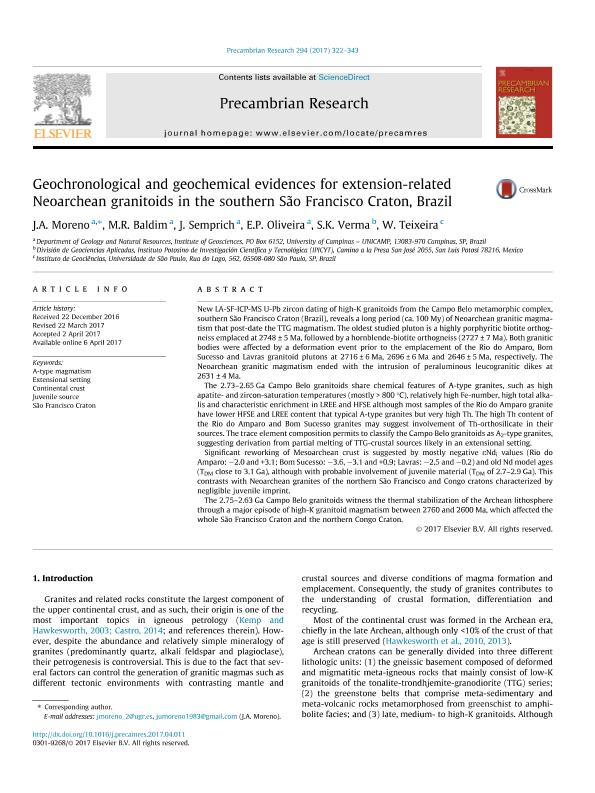Artículo
Geochronological and geochemical evidences for extension-related Neoarchean granitoids in the southern São Francisco Craton, Brazil
Fecha de publicación:
06/2017
Editorial:
Elsevier Science
Revista:
Precambrian Research
ISSN:
0301-9268
Idioma:
Inglés
Tipo de recurso:
Artículo publicado
Clasificación temática:
Resumen
New LA-SF-ICP-MS U-Pb zircon dating of high-K granitoids from the Campo Belo metamorphic complex, southern São Francisco Craton (Brazil), reveals a long period (ca. 100 My) of Neoarchean granitic magmatism that post-date the TTG magmatism. The oldest studied pluton is a highly porphyritic biotite orthogneiss emplaced at 2748 ± 5 Ma, followed by a hornblende-biotite orthogneiss (2727 ± 7 Ma). Both granitic bodies were affected by a deformation event prior to the emplacement of the Rio do Amparo, Bom Sucesso and Lavras granitoid plutons at 2716 ± 6 Ma, 2696 ± 6 Ma and 2646 ± 5 Ma, respectively. The Neoarchean granitic magmatism ended with the intrusion of peraluminous leucogranitic dikes at 2631 ± 4 Ma. The 2.73–2.65 Ga Campo Belo granitoids share chemical features of A-type granites, such as high apatite- and zircon-saturation temperatures (mostly > 800 °C), relatively high Fe-number, high total alkalis and characteristic enrichment in LREE and HFSE although most samples of the Rio do Amparo granite have lower HFSE and LREE content that typical A-type granites but very high Th. The high Th content of the Rio do Amparo and Bom Sucesso granites may suggest involvement of Th-orthosilicate in their sources. The trace element composition permits to classify the Campo Belo granitoids as A2-type granites, suggesting derivation from partial melting of TTG-crustal sources likely in an extensional setting. Significant reworking of Mesoarchean crust is suggested by mostly negative εNdi values (Rio do Amparo: −2.0 and +3.1; Bom Sucesso: −3.6, −3.1 and +0.9; Lavras: −2.5 and −0.2) and old Nd model ages (TDM close to 3.1 Ga), although with probable involvement of juvenile material (TDM of 2.7–2.9 Ga). This contrasts with Neoarchean granites of the northern São Francisco and Congo cratons characterized by negligible juvenile imprint.
The 2.75–2.63 Ga Campo Belo granitoids witness the thermal stabilization of the Archean lithosphere through a major episode of high-K granitoid magmatism between 2760 and 2600 Ma, which affected the whole São Francisco Craton and the northern Congo Craton.
Archivos asociados
Licencia
Identificadores
Colecciones
Articulos(CICTERRA)
Articulos de CENTRO DE INVEST.EN CS.DE LA TIERRA
Articulos de CENTRO DE INVEST.EN CS.DE LA TIERRA
Citación
Moreno Moreno, Juan Antonio; Baldim, M.R.; Semprich, J.; Oliveira, E.P.; Verma, S.K.; et al.; Geochronological and geochemical evidences for extension-related Neoarchean granitoids in the southern São Francisco Craton, Brazil; Elsevier Science; Precambrian Research; 294; 6-2017; 322-343
Compartir
Altmétricas




